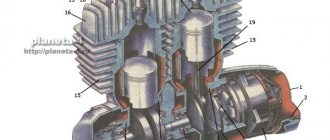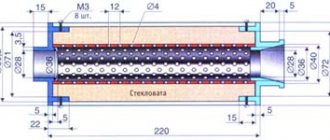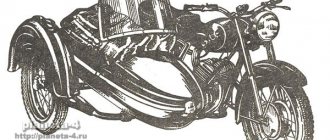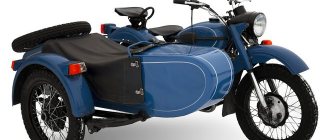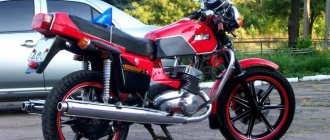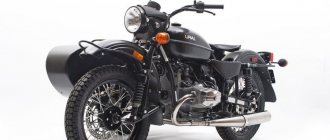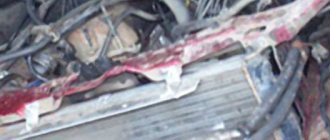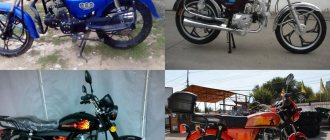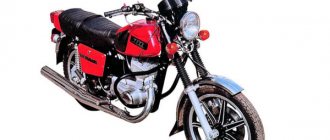Izhevsk motorcycle can certainly be considered one of the most elegant and reliable. Being very light and compact, this motorcycle is capable of carrying incredibly large loads. Thus, the IZ Jupiter 5 engine is capable of withstanding a load of 500 kg !
This is an excellent result. The motorcycle itself looks sporty. Classic minimalism of the Soviet period was intended more for the youth of that time, but was popular among all age groups.
IZH has the ability to install a cargo module or stroller, which is very convenient when transporting passengers or massive cargo. At the same time, it has excellent cross-country ability on any soil or road surface. However, traction is significantly reduced in wet weather, and stability issues may arise in muddy conditions.
The unit is very unpretentious to weather conditions. In severe frost, down to -30 degrees, starting the engine is not difficult. Even in extreme heat, there are no problems with overheating.
The characteristics of the IZH Jupiter 5 engine were quite good for Soviet times. The two-cylinder engine produced about 25 horsepower, allowing the bike to accelerate to 120 km/h. For comparison, Ural and Dnepr motorcycles had an average maximum speed of approximately 110 km/h . However, like any Soviet bike, problems arise with reliability. Frequent engine repairs of the IZH Jupiter 5 are part of the operation of the motorcycle.
Instructions for assembling and disassembling the IZH Jupiter 5 engine
First, you need to understand the features of the motorcycle.
IZH Jupiter-5 is a vehicle designed for road travel with different surfaces. You can attach a stroller and a cargo module. The appearance of Jupiter-5 is distinguished by the strict classics inherent in the Soviet era, but at the same time it has its own individuality. The demand for this model lies in the small dimensions of the motorcycle, as well as decent power for that time. The engine of this motorcycle has two cylinders and two strokes. The cylinders are arranged in-line. The maximum developed power reaches 25 horses, which is 3 more than the single-cylinder IL Planet-5. This engine allows the motorcycle to move at a maximum speed of 120 km/h, while it has low fuel consumption.
The Izhevsk Machine-Building Plant began producing IZH Jupiter-5 in 1985, so spare parts are always available. However, the quality leaves much to be desired, which is why parts wear out quickly and the motorcycle requires fairly regular repairs. Sometimes, to find the cause of a breakdown, you have to disassemble half of what you didn’t even know about. Fortunately, in IZh everything is quite simple and the repair can be done at home. Repairing the IZ Jupiter 5 engine is not a difficult task, but if you are going to ride this motorcycle often, then you should not neglect to do the work correctly.
The main problems of Jupiter-5 include the current shock absorbers and cylinders, which alternately refuse to operate the engine. If you have encountered similar problems, then this article may help you in solving one of the annoying problems.
Modernization
“Izh Jupiter” served as the beginning of a whole series of two-cylinder motorcycles:
- "Izh Jupiter-2" (1965-1971) - engine power 19 hp. at 4900 rpm
- “Izh Jupiter-3” (1971-1977) - power increased by almost 40 percent compared to its predecessor (25 hp at 5,700 rpm). The model was awarded the USSR State Quality Mark.
- "Izh Jupiter-3-01" (1977-1980) - engine power increased to 27 hp.
- "Izh Jupiter-3-02" (1979-1981)
- "Izh Jupiter-4" (1982-1985) - engine power increased to 28 hp. at 6,200 rpm, torque up to 3.58 kgf m, 12-volt electrical equipment, new lighting equipment.
- “Izh Jupiter-5” (IZH 6.113; IZH 6.114) (1985-1988) - engine power reduced to 24 hp. at 4800-5600 rpm, but the torque characteristics in the mid-speed range are improved. An “emergency start” button has appeared, which closes the generator excitation winding to ground, bypassing the voltage regulator, when starting with a dead battery.
- “IZH Jupiter-5-01” (IZH 6.113-01; IZH 6.114-01) (since 1988) - the motorcycle received a completely new appearance, unified with IZH Planet 5, released in 1987. The shape of elements such as the fuel tank, tool box lids, seat, and dashboard has been changed. Two cooling fins were added to the engine cylinders, nine instead of seven, the front part of each fin was bent towards the cooling air flow. A wide motor chain was installed, as a result of which the teeth of the motor sprocket and large clutch drum were changed.
- “Izh Jupiter-5-03” (Izh 6.113-03; IZh 6.114-03) (since 1993) - the model is equipped with a liquid-cooled engine IZH-Yu5 Sb. 1-08. Fuel consumption is reduced by 1.5-2 liters, noise level is reduced by 30%, engine power is 25 hp.
How to disassemble the IZ Jupiter 5 engine
So, disassembling the IZ Jupiter 5 engine includes the following steps:
Now that you have looked at all the parts from the inside and found the problem, we replace the broken part. The easiest way is to look on the Internet at a spare parts sales site. You can also find it at a regular city market (flea market). Before assembling the IZH Jupiter 5 engine, carefully inspect its surface for chips, cracks, and wear again.
After you have thrown out the broken part and stuck a new, shiny one in its place, you need to return everything to the way it was. Assembling the IZ Jupiter 5 engine is a little more difficult than disassembling it. Everything is put together in reverse order.
As you can see, there is nothing complicated about this. It's another matter if you want to add a couple of horses to your pet. Then you will have to sweat a little, because tuning the IZ Jupiter engine will require a little patience from you.
Tuning the IZH Jupiter engine
Before you start, you need to decide how much power you would like to give to your engine. If you are quite satisfied with the average power, then you will need a ZiD-200 resonator. But if you want to make the IZH Jupiter 5 motorcycle fast and powerful, start tuning the engine by installing a resistor from the SMB-5 “motoblock”.
Replacing the air filter plays a big role in engine modification. The better the air is cleaned, the more horses the engine will be able to produce. After all, the degree of engine overheating depends on the amount of incoming air. It is best to use imported air filters. They provide improved cleaning and longer service life.
Next you should work hard on the injection system. An excellent option is to install a “Planet” carburetor with a diffuser diameter of 0.32 cm. Two carburetors will provide much greater acceleration and good dynamics. We take the flanges securing the cylinder from the standard tube, grind out the aluminum studs, and cut off the flange from the carburetor from the inlet tube from the Planet.
We grind the ends of the cylinder heads on a machine, and press the cylinders themselves. The maximum permissible volume of PIC is 18 cubic meters. see Install factory copper layers under the cylinder heads. And we adjust the ignition advance angle to increase compression.
We use the second flange from the old carburetor. Then we weld the parts using “cold” welding. And finally, we modify the assembly to be compatible with the inlet channels. all the cracks with epoxy liquid . Voskhod carburetors will provide uniform traction. In this simple way, you can add not only a couple of additional horses to your pet, but also provide more lively dynamics that give a good riding experience. The motorcycle is very reliable for everyday use, and if you take good care of it, breakdowns will occur very rarely.
[sc:ads5]
Source
Description of design
So, this motorcycle was first shown in 1971.
It was produced in two versions - “IZH Jupiter 3” and “IZH Jupiter 3K”.
They differed in that the “3K” was additionally equipped with a side stroller, but it had the ability to be detached from the motorcycle.
At that time, Jupiter 3 had a modern appearance and was well made, although it was based on its predecessor. All elements of the motorcycle were attached to a tubular frame.
To increase comfort, the front suspension travel was increased and the rear shock absorbers were made softer.
They changed the shape of the tank, it stopped being teardrop-shaped. But the headlight did not change; its housing continued to house the speedometer, ignition switch and warning lamps.
The seat is undivided, double. A rear fender with a brake light, turn signals and a license plate placed on it was attached to the seat body from below.
Turn signals on the IZH Jupiter family began to be installed precisely from the third model.
There were glove compartments under the seat on both sides of the motorcycle, the left one was intended for installing the battery, and the right one was for storing keys.
The engine was located under the tank, which ensured that fuel flowed into the carburetor by gravity. To prevent spontaneous leakage of gasoline, a tap was placed on the tank.
The cylinders had an in-line arrangement. When designing a new engine for this motorcycle, the position of the cylinder fins was revised, which subsequently ensured better cooling.
One elbow came out of each of the cylinders, to which two exhaust pipes were screwed, mounted on the sides of the motorcycle under the footpegs.
The power system consisted of a single carburetor located behind the cylinders and connected to them by a pipe with a double outlet. In the base, the motorcycle came with protective covers covering the carburetor.
By reworking the engine, the designers managed to increase its power by 6 hp, which affected the speed; it increased to 120 km/h.
The gearbox was made integral with the engine. Torque was transmitted via a multi-plate clutch. The drive to the rear wheel was carried out by a chain.
The rear drive sprocket was housed in an aluminum housing.
The front suspension was made in the form of a telescopic fork, and the rear suspension was a pendulum with two shock absorbers.
The brakes on both wheels are mechanically driven drums.
At one time, this motorcycle was awarded the State Quality Mark because it was reliable, easy to repair, and easy to start, compared to the IZH Planet.
Its only weak point was the contact ignition system. It practically consisted of two contact systems, one for each cylinder.
This affected the convenience of installing the ignition; it was difficult to achieve the same advance angle on the cylinders.
Engine tuning Izh Jupiter 5. Four cylinders instead of two. Is it possible to?
I always wanted to have a big, powerful motorcycle with good dynamic qualities, superior, if not to Japanese motorcycles, then at least to fast cars. Unfortunately, I only had IZH-Jupiter (not everyone has money for Japanese motorcycles). So neat, reliable, cheerful, by Izhevsk standards, my Izhik.
The history of the creation of one Izh.
And then I thought about creating a 4-cylinder IZH-Jupiter! Sleepless nights began searching for information, thinking about the idea of pairing two Jupiter engines, searching for source material and other worries... Still, I found one useful article with a photo on the Internet, and it also turned out that my friend’s father had already assembled such an engine from two Izhevsk ones. And this is in the 80s! The idea turned out to be much older! Also, my friend Roman gave me a prototype of a coupling between the engines. The engines had to be connected by a connecting coupling, which consisted of two mats with flanges; internal cones were machined into the cylindrical halves for the axles of the engine crankshafts. Each of the clutch halves was screwed onto the crankshaft like a sprocket, and the two halves were screwed together with flanges.
IZH-1 - the first motorcycle of the Izhevsk Motorcycle Plant (9 photos)
On December 4, 1928, the first samples of domestic motorcycles, named Izh-1, came out of pilot production in Izhevsk (now OJSC Izhevsk Motorcycles).
See all photos in the gallery
At the end of the 20s, the Avtodor council sent P.V. Mozharov on a business trip to foreign factories. From there he brought several German motorcycles of different brands, instruments and tools.
Petr Vladimirovich Mozharov
At the same time, Avtodor purchased 14 well-proven English and American motorcycles, gave them bench tests and tested them (the then famous tester S.I. Karzinkin was involved in this matter) in the 1st All-Union Motorcycle Rally in 1928.
Leningrad engineers with L-300 (far right - Mozharov)
Mozharov, who took part in it on a German Neander, pleased the riders and spectators with the words: “... a Soviet motorcycle has already been designed, suitable for riding on our roads. Now the Izhevsk plant has started assembling such machines, by spring the first three prototypes will be ready, which we will probably present for the next motorcycle rally, and then Ruzhpultrest will begin their mass production.”
Indeed, in the fall of the same year, several experimental motorcycles began to be designed and built in Izhevsk. However, not everything went smoothly, and for the start of the 2nd All-Union Motor Ride, only IZH-1 was prepared (I. Shchedrin’s team of mechanics completed training on September 17, 1929), IZH-2 and IZH-3, and two more “IZH-4” and “IZH-5” were getting ready, but they were hopelessly late for the start.
So they were sent on the run untested, with unadjusted carburetors... Nevertheless, all five successfully completed the 3,300-kilometer route and finished in Moscow.” IZH-1 and IZH-2 were almost identical, equipped with four-stroke, two-cylinder, V-shaped engines with a displacement of 1200 cm3, maximum power of 24 hp. With. at 3000 rpm.
Magneto ignition. The engine was located across the frame. The gearbox had three stages. Drive to the rear wheel is by cardan shaft. The wheel of the side trailer (sidecar) was also driven, so the cars walked confidently off-road; 23 liters of fuel in the gas tank was enough for 300 km, the maximum speed reached 65 km/h. The front fork is parallelogram.
The motorcycle is based on a stamped frame made of two solid trusses. The lower part of the frame also served as a muffler housing - this feature was characteristic of all five motorcycles of the first series. It was an impressive car in terms of weight and dimensions with a two-cylinder four-stroke V-twin engine with a displacement of 1200 cubic meters. cm and maximum power of 24 hp.
The engine crankshaft was located longitudinally, torque was transmitted to the rear wheel from a three-speed gearbox, mounted in a block with the engine and driveshaft. The machine was intended for operation with both passenger and cargo trailers. The power reserve ensured the ability to drive on the most difficult roads.
Characteristic:
Engine displacement is 1200 cm3. Number of power strokes – 4. Number of cylinders – 2. Number of gears – 3. Reverse gear – cardan shaft. The fork is parallelogram. Wheelbase, mm – 1400 Ground clearance, mm – 120. Weight without side trailer, kg – 300.
The vehicle was intended for operation with both passenger and cargo trailers. The power reserve ensured the ability to drive on the most difficult roads.
Technical characteristics of the Izh Jupiter 5 motorcycle engine
Izhevsk motorcycle can certainly be considered one of the most elegant and reliable. Being very light and compact, this motorcycle is capable of carrying incredibly large loads. Thus, the IZ Jupiter 5 engine is capable of withstanding a load of 500 kg !
This is an excellent result. The motorcycle itself looks sporty. Classic minimalism of the Soviet period was intended more for the youth of that time, but was popular among all age groups.
IZH has the ability to install a cargo module or stroller, which is very convenient when transporting passengers or massive cargo. At the same time, it has excellent cross-country ability on any soil or road surface. However, traction is significantly reduced in wet weather, and stability issues may arise in muddy conditions.
The characteristics of the IZH Jupiter 5 engine were quite good for Soviet times. The two-cylinder engine produced about 25 horsepower, allowing the bike to accelerate to 120 km/h. For comparison, Ural and Dnepr motorcycles had an average maximum speed of approximately 110 km/h . However, like any Soviet bike, problems arise with reliability. Frequent engine repairs of the IZH Jupiter 5 are part of the operation of the motorcycle.
Motorcycle appearance
When the Jupiter 5 model came out, its design was already well-known, because it was inherited from the Jupiter 4 motorcycle. But soon the Izh Planet 5 appeared on sale, and the developers saw that they could borrow several design elements.
The first modification had a square-shaped dashboard, which consisted of several indicators, an ignition switch and a speedometer. But soon its appearance was redesigned, and instead of one dashboard there were two. On the first part they placed warning lamps, and on the second part they decided to put a speedometer.
The design of the fuel tank has also been slightly redesigned, with rubber pads on the knees and the shape of the tank itself has become slightly different. Accordingly, in the new modifications of the Moto Izh Jupiter 5, it received a different, longer seat that ended at the brake light. This innovation is still considered stylish and modern.
During the Soviet era, creating high-quality and impressive equipment was as easy as shelling pears, because the country had all the resources for this. Thus, the Izhevsk plant produced a motorcycle that is capable of carrying a load of up to 500 kg. Just imagine what could be carried on this transport!
Being a workhorse, the motorcycle had a fairly sporty appearance and excellent top speed. With a power of 25 hp. the motorcycle could accelerate to 120 km/h. This is a completely standard indicator, because another representative of the Dnepr could give a maximum speed of 110 km/h. In severe frosts down to 30 degrees, the unit started up perfectly, which cannot be said about the current new products. Unfortunately, many owners complain of frequent engine breakdowns due to their long lifespan.
Main problems and their solutions
Disassembling the IZ Jupiter 5 engine, the video of which is presented below, is carried out not only as problems arise, but also for preventive purposes. For example, cleaning the carburetor is one of the conditions for maintaining stable engine operation.
The IZ Jupiter 5 engine diagram is simple even for inexperienced motorists. Therefore, during repairs there will be no difficult issues. In most cases, breakdowns occur due to the negligence of owners who improperly operate the moped and do not perform regular maintenance. For example, incorrect selection of oil for a particular time of year. So, if any part wears out, it must be replaced.
Engine diagnostics and repair
It is sometimes impossible to find the cause of a breakdown after one visual inspection. In some cases, complete disassembly of the IZH Jupiter 5 engine is necessary. But if you find out the reason, you can quickly solve the problem yourself. Here are examples of main faults and repair recommendations:
These are the main problems that may occur during operation. How to disassemble the IZ Jupiter 5 engine is written in detail in the maintenance book issued upon purchase. Everything stated in it is written in clear text, with diagrams and detailed instructions. Not only the repair of a Soviet unit is within the power of any owner.
There are many questions about how to assemble the IZH Jupiter 5 engine yourself, modifying it. For example, installing a more reliable carburetor or a more stylish and loud muffler can be done quickly enough without significant financial investments.
What carburetor is used on the IZ Jupiter 5 model
IZH Jupiter 5 is the latest and most modified model in the series. The first “fives” were transitional: facing from model 4 and a K-62D carburetor. Then, an updated version was put into production - IZH Jupiter 5-01, the motorcycle received an interchangeable lining with IZH Planet 5 and carburetors K-65D, K-68D and Jikov-2928CE. The latter was taken from the Czechoslovakian motorcycle Java-638, which had similar engine parameters to the Jupiter.
Later, Izhmash presented a modified version of the Jupiter engine with water cooling. The so-called “dropsy” had the same engine power as a conventional engine, but the engine’s noise level and fuel consumption decreased. A new K-68D carburetor was also installed on it. Its feature was the new cylindrical shape and material of the throttle valve (like Jikov), which reduced its wear. Idle speed has become more stable.
Electrical equipment IZH Planet 5
Wiring for IZH Planet 5 includes:
- generator;
- battery;
- ignition system;
- headlights;
- control devices;
- switching elements.
Video: review of IZH Planet 5 wiring
Taken by user Agronom.
Generator
IZ Planet 5 generator design:
- voltage regulator with rectifier BPV-14-10 - 1;
- rotor - 2;
- stator with windings - 3;
- current collector brushes - 4;
- ignition system cam (battery) - 5;
- ignition system contact unit - 6.
The generator converts the mechanical energy of a gasoline engine into electrical energy, which charges the battery. Alternating current is generated by 3 windings and fed to a rectifier, which converts it into direct current. An additional coil is used as an exciter.
Photo gallery: IZH Planet 5 generator and its design
Battery
To supply all components, a low-power energy storage device of 12 volts is required, since IZH Planet 5 does not have a starter. The purpose of a lead-acid battery is only to supply voltage to the ignition system and the excitation winding of the generator during startup.
Ignition system
In IZH Planet 5, the ignition coil converts low-voltage voltage into high-voltage and transmits it to the spark plug. That, in turn, is responsible for the spark that detonates the fuel. To ensure that detonation occurs only in the desired piston position, there is an ignition chopper.
From the factory, this model is equipped with a classic ignition system, which requires periodic cleaning of the breaker contacts and adjusting the gap between them.
Installing a contactless SG on a motorcycle gives:
- timely powerful sparking;
- reduction of vibration levels;
- reduction in fuel consumption.
Control devices
The following control devices are installed on the motorcycle:
- tachometer, on which there are indicator lights for the headlights and turns;
- speedometer showing total and daily mileage;
- power engine temperature indicator;
- voltmeter.
Headlight and dashboard lamps
Conventional incandescent lamps are installed as lighting equipment and to illuminate the dashboard. Switching elements are responsible for supplying electricity from the battery to the lamps.
The headlight circuit includes lamps:
- headlight (35 watt);
- parking light headlights (4 W);
- control - blue light (2 watts);
- rear brake light (15 W).
Switching elements
Switching elements are various types of switches that close or open an electrical circuit. They can be activated using keys on the dashboard (for example, turn signals) or by sensors.
In IZH Planet 5, the switching elements include:
- turn switches;
- signal key;
- switches for low/high beam headlights;
- neutral sensor;
- egnition lock;
- foot and hand brake sensors.
The design and principle of operation of the IZH Jupiter 5 carburetor
As mentioned above, the IZH Jupiter 5 motorcycle was equipped with a K-65D carburetor from the factory. It is float-type, gate type with variable vacuum. This means that the vacuum parameters in the carburetor diffuser are not constant and depend on the height of the throttle valve with the needle. Such carburetors are designed for leisurely, quiet driving over rough terrain and when driving with additional cargo (cradle, trailer).
The main components of the K-65D carburetor include the following components (see figure):
The carburetor works on the principle of a spray gun. Due to the difference in pressure in the engine crankcase and the environment, fuel is sucked through the atomizer into the mixing chamber, where it is mixed with air. As the crankshaft speed increases (the throttle rises), the pressure at the outlet of the mixing chamber decreases, but the air flow speed increases, due to which the fuel supply increases.
For the correct dosage of fuel at different engine operating modes, a conical-cylindrical needle is used in the carburetor. Due to this, when the throttle is raised, the needle in the atomizer changes the flow area, which allows you to maintain the required vacuum parameters.
To allow the engine to operate at idle speed, there is an air channel in the diffuser on the intake side. Passing through it, the air mixes with the fuel entering through the idle jet. As a result, the finished mixture enters the space behind the throttle. Thus, the engine maintains a minimum stable engine speed.
Two carburetors on IZ Jupiter
Among all the various modifications for the two-cylinder Izh, the installation of two carburetors on the motorcycle engine stands out. One for each cylinder. This is done in hopes of increasing engine power by improving the filling of each cylinder. The power does increase, but at most by a couple of horses.
In addition to modifying the intake ports, it will be necessary to install a reed valve on each cylinder. If this is not done, then when the engine is running, the mixture will spit back into the air filter and the filling will deteriorate. It is normal for the mixture to be thrown back into the carburetor when a two-stroke engine is running. Thus, the engine “breathes”.
Therefore, on most two-stroke vehicles there is an intake resonator between the carburetor and the filter. It is a plastic box into which part of the mixture is spat out. This device is not available on Jupiters, because there is no particular need for it due to the length of the “pants” and the peculiarities of the two-cylinder engine. While one cylinder is making its stroke, the second one sucks in the mixture from the carburetor plus the part that was reflected from the skirt of the first piston.
In addition, installing a reed valve will improve cylinder filling at low and medium speeds, and fuel consumption will be slightly reduced. The Jupiter cylinder is approximately equal to the volume of 175 cm3, so the reed valves can be supplied from sunrise 3m-01 or made from a turner according to a sample. Carburetors can also be taken from Voskhod (K-62V, K-65V) or from Java 638.
In addition to installing the valves, the pistons will also need to be modified. A hole must be made on the piston skirt on the inlet side, as shown in the figure. This is necessary in order to reduce the inlet resistance necessary for the operation of the petals.
To operate two carburetors, you will need a tap with a double and a common throttle handle for both cables. These parts can be taken from the Urals or picked up from other motorcycle models.
After installing all the parts, it is necessary to configure and synchronize the carburetors. Otherwise, overheating and wear of one of the cylinders, as well as severe vibration, may occur.
Required Parts
In order for the ignition system to work correctly, a number of auxiliary parts are required. They are listed below:
- Switch for BSZ VAZ cars. You should not choose exclusively from the low price segment. The Astro switch has a lot of positive reviews;
- Hall Sensor. The best option for Jupiter 5 is a similar manufacturer VAZ. By purchasing it in branded packaging, you protect yourself from counterfeits;
- Ignition coil with two terminals. You should choose between the gazelle engine number 406 or Oka with an electronic ignition system;
- A pair of silicone armor wires with rubber caps;
- The modulator is a butterfly-shaped plate made of iron.
Modulator
The most difficult stage is the production of the modulator. It is important to maintain the required shape. The more accurately the required dimensions are observed, the lower the likelihood of problems occurring after the system is implemented, that is, there will be no need to adjust it with a file. The ignition timing must match on any cylinder used.
The bolt hole must be located in the middle. Otherwise, the engine operation will not be synchronized. It is also recommended to check the integrity of the crankshaft bearings. If you find defects, you should immediately replace it.
The contact ignition is not able to work normally if the bearings are damaged. The thickness of the part should not exceed one and a half millimeters. If it is thin, it will not be possible to avoid deformation, and if it is thick, it will come into contact with the surface of the hall sensor housing.
To create the plate, it is allowed to use any material except steel. Aluminum and others should not be used as they are not magnetic. The drawing that must be followed can be found in the public domain. The presented diagram will be useful to those people who decide to modernize the vehicle ignition device. Below are methods for installing electrical ignition devices in Jupiter.
It must be turned by a professional turner. He will make a simple disk and draw on it the markings of elementary distances between the corners. Then, in accordance with it, you will cut out the necessary sectors at home. The cost of the modulator is seventy rubles.
It is not advisable to use an ordinary plate, since its width is less than twelve millimeters. This will not be enough to fully accumulate the energy resource in the coil. Of course, it can be installed, but achieving four thousand revolutions per minute will become impossible.
In addition to the above you will need:
- A stud with an applied thread of seven millimeters, pitch 1, as well as a pair of nuts with washers of the corresponding parameters. The priority material for these components is brass. This is explained by the least magnetization of the plate from the generator rotor. If you use a standard bolt, then difficulties may arise with the introduction of ignition. The bolt tends to follow the modulator as it is tightened. However, it is necessary to observe the leading indicator, maintain the same position of the rotor and modulator, and tighten the bolt. It is advisable to use a pin, since many are not able to perform all the necessary actions in total;
- A set of wires with connectors for ignition without contact from VAZ. This part can be purchased or made with your own hands.
Adjusting the carburetor of the IZH Jupiter motorcycle
Setting up Peker carburetors on the IZH Jupiter 5 motorcycle is carried out as follows. First, we check the tightness and integrity of the air filter. Then we check the serviceability of the ignition. After this, we proceed to adjustment, the algorithm is as follows:
A few words about setting up the Jikov-2928CE carburetor. The idle speed setting here is similar to that of the K-65. The only differences are in the location of the adjusting screws. In Jikov they are conveniently located on the side of the carburetor (the one that is screwed in at an angle is responsible for the height of the throttle valve).
Alternative carburetor for motorcycles IZH Jupiter 4, 5
Today, the market offers many options for spare parts for motorcycles, including carburetors. If the old carburetor has become unusable, and repair kits no longer help, you can choose an alternative modern option. The main thing is to observe such parameters as the diameter of the diffuser and the throughput of the jets (main and idle).
This carburetor has one “trick” - an accelerator pump. At high engine speeds, it injects additional fuel into the diffuser to combat the lean mixture that is typical of slide carburetors when the throttle is opened sharply. For its operation, you will need a special double cable, which works in tandem with the throttle cable.
Keihin PZ30 carburetor
This is what the Keihin PZ30 looks like on the IZH Jupiter 5 motorcycle
You can also install Japanese Mikuni vm 28.30 carburetors on the Jupiter. These carburetors are not cheap because they are rare. It is very difficult to find a whole, unworn Mikuni (not to mention repair kits for them), because... The Japanese abandoned them a long time ago and are now producing motorcycles with electronic injection.
Today there are many Chinese copies of K-62, K-65 and even Jikov carburetors on the market. With some modification of such carburetors (replacing the internals with Soviet components, drilling the missing holes), they perform their functions quite well.
